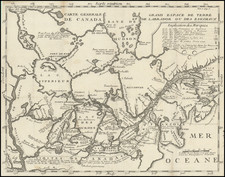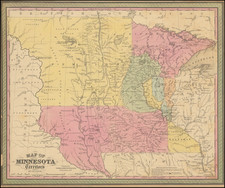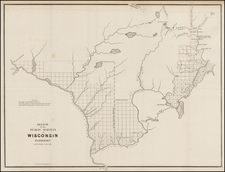The first printed map of the Mississippi River.
Fine example of the German edition of Thevenot's map of the Mississippi River, the earliest separate map depict the expedition of Louis Jolliet and Father Jacques Marquette down the Mississippi River.
In 1663, the French government began a more systematized effort to search for furs, minerals, and a shorter route to China. The initial objective was locating the Mississippi River, whose existence was known through Indian reports. An expedition was sent out under the command of Louis Jolliet, a fur trader and explorer, and the Jesuit Father Jacques Marquette. Jolliet and Marquette left Green Bay in May 1673, and by following the courses of the Fox and Wisconsin rivers, reached the upper Mississippi River. Continuing south, they discovered the mouths of the Missouri, Ohio, and Arkansas rivers, before turning back out of fear of encountering a Spanish force. On the return trip, they found a short cut to Lake Michigan by following the Illinois and Des Plaines rivers to a portage at Chicago.
Several manuscript maps survive based on the discoveries of the Jolliet and Marquette expedition. This map was first adapted for inclusion in Melchisedech Thevenot's
Recueil des Voyages, Paris, 1681. It shows for the first time on a printed map the Mississippi and its tributaries north of the Arkansas based upon first-hand observation. The depiction of the river between the Arkansas and the gulf is based on speculation. It is also the first map to include the place name Michigan ("Mitchigami").
This second edition of the map appeared in the rare 1689 German book which included an edition of Hennepin's
Description de la Louisiane, to which Thevenot's account of Jolliet and Marquette's expedition was appended. Both editions of the map are rare. The cartography in the second edition is identical to the first, but in the second state the title and one or two legends have been translated from French into Latin.
A fine example of a landmark map.









![[ Southern Railroads ] Railroad Map of the Southern States Shewing the Southern & Southwestern Railway Connections With Philadelphia. 1862 . . . Prepared by Thomas Kimber Jr., Chairman of the Committee on Inland Transportation of the Board of Trade of Philadelphia](https://storage.googleapis.com/raremaps/img/small/103211.jpg)



![[The First Maps Printed Color] Cartes en Couleur des Lieux Sujets aux tremblements de Terre Dans toutes les parties du Monde Selon le Sisteme de l’impulsion Solaire](https://storage.googleapis.com/raremaps/img/small/52293op.jpg)
